Last week I blasted a bunch of ammo through a 41magnum python (conversion by Jack Huntington) and it didn't blow up. A lot of people were skeptical a python could handle 41 mag loads so it was a pretty nerve wracking first few shots.
E.g., here's dfariswheel's recounting of the background of the ill fated 41
magnum attempt by colt (from http://forums.1911forum.com/showthread.php?p=1975991 ):
Colt NEVER cataloged OR SOLD any of them.
They were all pure experimentals that were never sold.
The ONLY genuine factory Pythons ever sold were in .357 Magnum and the Colt
Target Python in .38 Special with an 8" barrel.
Colt did make ONE .256 Python. It fired one shot, locked up, and was never
fired again. It's in the Colt museum.
Colt made about TWO or three .41 Magnum Pythons on request of a large
distributor.
Colt had second thoughts about the safety and took all of them back.
These .41 Mag Pythons are now in the Colt museum.
NONE were ever sold or allowed outside Colt custody.
Colt put a .22LR Python on a catalog cover, but the gun was never made, and
the picture on the cover was an airbrushed artists picture of what it would
have looked like.
There are "Colt Python" .41 Magnum guns around.
These WERE NOT made by Colt. These were made by some custom gunsmith in
Florida??
After customers sold the guns to other people who didn't know they weren't
factory guns, they started shooting them, and they started coming apart.
They returned them to Colt demanding they be repaired.
Colt traced the custom maker down, and he quickly closed up shop and left
town, one step ahead of Colt and customer lawyers.
These fake .41 Magnum Pythons turn up from time to time, ALWAYS with the
inference that they are Genuine Colt Factory Pythons.
They often have the story that Colt won't issue a factory letter on them
because they somehow "Slipped out of the factory".
They aren't Colt, Colt didn't make them and Colt strongly denies they made
them.
There is at least one other fake .41 Magnum Python around, but it's so crudely
made and the markings are so crudely done, no one argues it's a factory gun.
Fact is, the .41 Magnum is simply to powerful for the Colt Medium frame, and
the .44 Special is physically too large.
There just isn't enough metal there to withstand the pressures.
An unanswered question is WHY a gunsmith with the skills and talent to make
the .41 Magnum guns, AND so closely fake genuine factory markings, would make
something he HAD to know wasn't safe.
Sellers or owners of fake .41 Magnum Pythons will dispute the facts and claim
that Colt is lying about them.
Again, while Colt did experiment with several other calibers of Pythons, all
of them are in the Colt museum and the only factory guns ever sold were in
.357 and .38 Special.
Last edited by dfariswheel; 11-15-2008 at 07:53 PM.
Despite the sensible warnings from grown ups, things went smoothly, other than I had some misfire issues in double action that I've still not figured out yet.
Jack stated that you could run 1,000 fps 41 mag loads through it all day and it'd be fine. After shooting around 150 or so (the range was closing so there wasn't time for a serious stress test) his statement seems plausible. The recoil isn't as sharp as near max 357 loads. And the gun seems very consistent. I wasn't aiming worth a damn but it'd pretty much put it where I pointed it: e.g., a 12 shot string all in a 4 inch shoot N C at 15 yards with no fliers. I was using Unique, which doesn't seem to meter well in my dillon so that is saying something.
Before we could shoot we had to make ammo. So here is what we have to work with. 500 new starline cases and two 500 bullet boxes of lasercast 215 gr bullets.
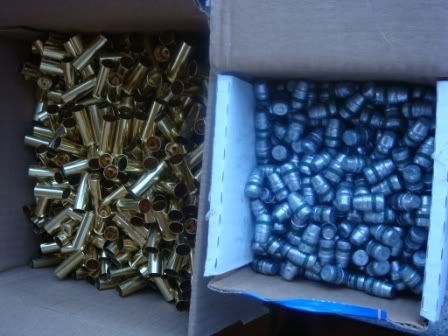
And here's a close up of new brass porn!

For comparison: 357 on left, 41 mag on right.
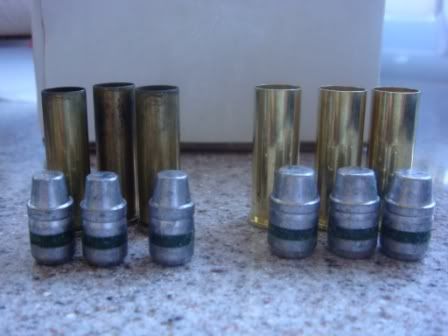
According to lyman's, 215 gr with 7.8 gr of Unique will give around 960 fps, so we make about 500 of these:
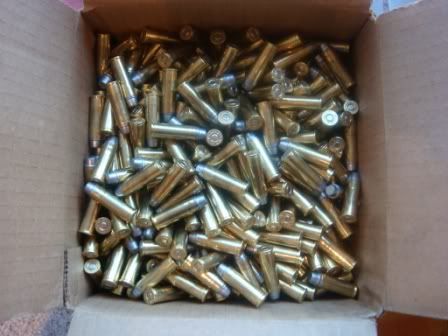
I have to say, it was not the most fun process. My dillon vibration based primer loader wasn't working worth a damn. Then the crimping part of the hornady dies kept falling out (first time this has ever happened) and the dillon crimper was behaving very strangely. (If I didn't know better I'd swear it was putting a taper crimp rather than roll crimp.)
However in the end we more or less wound up with what we wanted.
After running the above through the gun at the range we get:

I'm going to do a more rigorous test with light and a bit less rushing, but as it stands, I think Jack did no harm to the accuracy. I'll not be shocked if 41 mag turns out to be slightly more consistent than 357, at least for my reloading setup.
Here's some photos of possible stress points: everything seems fine so far.
The forcing cone looks fine, though like all of the gun at this point, very dirty (I've not found lasercast to be a clean round: I like Penn bullets a lot better, but they take months, so ...):
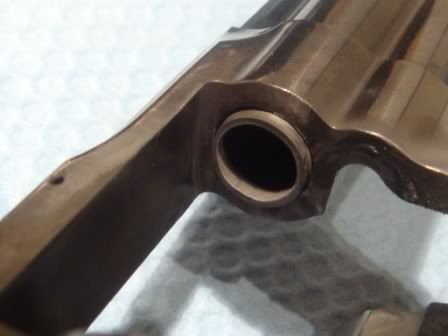
No cracks in the rear of the frame, though I don't remember there being shell outlines to this degree:
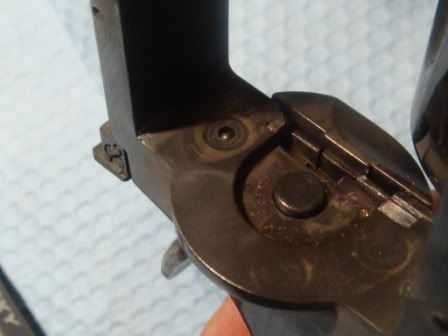
The previous owner stated he only fired 6 (or 8?) rounds through the gun, so we've increased that by a factor of 20x on our first visit and it shows :)
No obivious damage in the chambers from at least a cursory inspection:
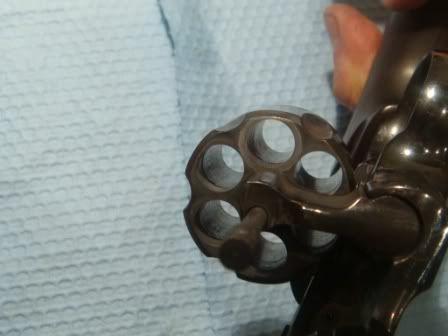
The one downside is that I was getting a lot of misfires in DA. Single action was fine, but if I did double action I'd get one or two misfires per cylinder. I'm not sure what the problem is. I'm using CCI large pistol primers which are pretty hard. The misfire looks like a light strike (much lighter than the fired chambers) but does not seem to consistently happen on just one chamber. The action is light, but I didn't think it was that light. Though perhaps igniting LP primers using a action setup for small pistol primers requires more force? I'm using a longer firing pin, so that's not an issue.
Along with headspace, firing pin potrusion, or a too light mainspring, another obvious thing to check when you get misfires is whether the hammer is hitting the rebound when it falls. We do this by pulling the trigger back, holding the rebound lever down:
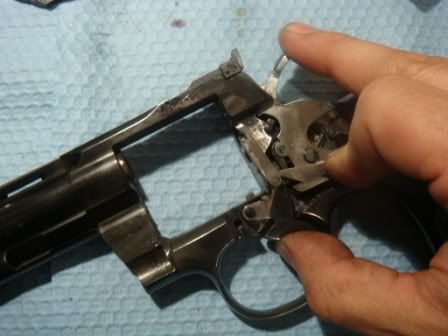
We then pull the hammer back (I recommend two hands and no camera for this):
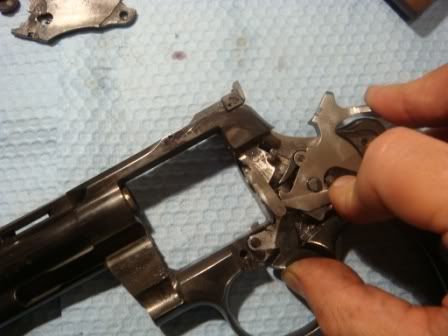
And release it, checking to see if we feel any vibration in the rebound:
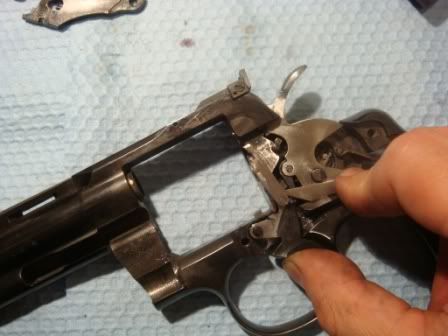
If you feel a hit, the rebound needs to be adjusted.
Unfortunately in this case, there's no problem, so I'm still not sure what the issue is. Current suggestions are "just use federal" (cheating!), to make sure primers are seated firmly (possible, though 1 misfire out of 6 seems high),
I'm pretty happy with this gun. I'm looking forward to shooting it a bunch. It's a way off, but I'm debating making a shooter m357 into a 10mm gun. Possibly starting w/ a barrel blank and attaching it to one of the ill treated ones I've picked up recently. One issue is that I think you'd need to use moon clips to shoot it, which is a bit annoying.

The 10mm conversion sounds interesting. Dave Clements converts GP-100 Rugers to this using the factory cylinder and barrel so might be the way to go. I do hear the moon clips cushion the hammer blow somewhat so one needs a bit more spring tension.
ReplyDeleteFWIW: John Linebaugh offered .41 Magnum conversions of the Python back in the early '80s.
ReplyDeleteAs for .40 caliber conversions, Colt reportedly played with a .400 Magnum in the 1960s. Whether or not this predated the .401 Herters PowerMag and .41 Magnum is not known.
http://www.singleactions.com/400Colt.pdf
There was a 40 caliber python from the 60s that went for $7,000+ at the second colt museum auction by Greg Martin. I wonder if that was the .400 magnum?
ReplyDeleteDoes anyone have a photo of the Linebaugh conversion? Especially the forcing cone and rear of the cylinder? I'm curious if he did any re-enforcing.
ReplyDeleteI was just thumbing through my copy of "Gun Digest Book of Gun Accessories & Services" (1979), and found the following entry:
ReplyDeleteBeal's Colt Python .40 BBI Conversion
.40 BBI ballistics, 1340 fps muzzle velocity with 170 gr. bullet. Coversion includes 6" barrel, custom cylinder, Pachmayr Signature grips, tuned action, wide smooth trigger, hard chrome finish, custom aluminum case plus 200 rounds of .40 BBI 170 gr.
Price: $1200 (approximately).
From Beal's Bullets Inc.
Unfortunately, there were no photos.
Ah, very interesting.
ReplyDeleteI picked up a nice Yuasa rotary table, so perhaps could ream out the cylinders for a .40. The bit more meat on the bones would make me feel a bit safer compared to the thin web left by the .41.
Fitting an aftermarket .40 barrel shouldn't be too bad either. (I am squimish about cutting out a stock python barrel unless it's already damaged.)
Thanks again Daniel!